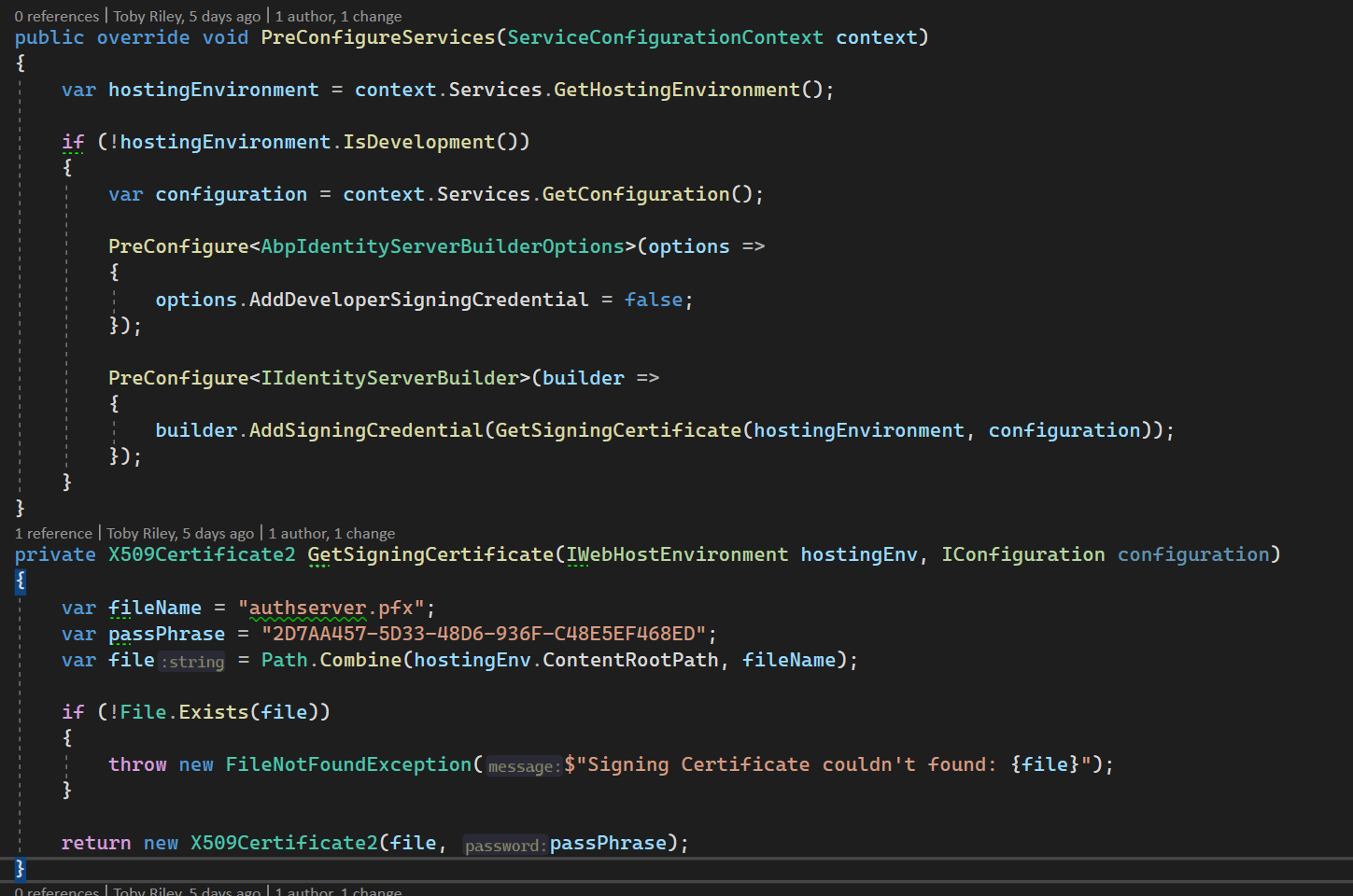Hi,
We are using the Microservices Template on APB 5.1.3. and have encountered an issue when deploying to a Linux container.
On container startup, we get the following issue:-
Volo.Abp.AbpInitializationException: An error occurred during ConfigureServicesAsync phase of the module Volo.Abp.IdentityServer.AbpIdentityServerDomainModule, Volo.Abp.IdentityServer.Domain, Version=5.1.3.0, Culture=neutral, PublicKeyToken=null. See the inner exception for details.
---> System.Security.Cryptography.CryptographicException: The certificate data cannot be read with the provided password, the password may be incorrect.
---> System.Security.Cryptography.CryptographicException: The certificate data cannot be read with the provided password, the password may be incorrect.
at Internal.Cryptography.Pal.UnixPkcs12Reader.VerifyAndDecrypt(ReadOnlySpan`1 password, ReadOnlyMemory`1 authSafeContents)
at Internal.Cryptography.Pal.UnixPkcs12Reader.Decrypt(SafePasswordHandle password, Boolean ephemeralSpecified)
--- End of inner exception stack trace ---
at Internal.Cryptography.Pal.UnixPkcs12Reader.Decrypt(SafePasswordHandle password, Boolean ephemeralSpecified)
at Internal.Cryptography.Pal.PkcsFormatReader.TryReadPkcs12(OpenSslPkcs12Reader pfx, SafePasswordHandle password, Boolean single, Boolean ephemeralSpecified, ICertificatePal& readPal, List`1& readCerts)
at Internal.Cryptography.Pal.PkcsFormatReader.TryReadPkcs12(ReadOnlySpan`1 rawData, SafePasswordHandle password, Boolean single, Boolean ephemeralSpecified, ICertificatePal& readPal, List`1& readCerts, Exception& openSslException)
at Internal.Cryptography.Pal.OpenSslX509CertificateReader.FromFile(String fileName, SafePasswordHandle password, X509KeyStorageFlags keyStorageFlags)
at System.Security.Cryptography.X509Certificates.X509Certificate..ctor(String fileName, String password, X509KeyStorageFlags keyStorageFlags)
at System.Security.Cryptography.X509Certificates.X509Certificate2..ctor(String fileName, String password, X509KeyStorageFlags keyStorageFlags)
at DataAdmiral.AuthServer.DataAdmiralAuthServerModule.GetSigningCertificate(IWebHostEnvironment hostingEnv, IConfiguration configuration) in /src/apps/auth-server/src/DataAdmiral.AuthServer/DataAdmiralAuthServerModule.cs:line 93
at DataAdmiral.AuthServer.DataAdmiralAuthServerModule.<>c__DisplayClass0_0.<PreConfigureServices>b__1(IIdentityServerBuilder builder) in /src/apps/auth-server/src/DataAdmiral.AuthServer/DataAdmiralAuthServerModule.cs:line 76
at Volo.Abp.Options.PreConfigureActionList`1.Configure(TOptions options)
at Microsoft.Extensions.DependencyInjection.ServiceCollectionPreConfigureExtensions.ExecutePreConfiguredActions[TOptions](IServiceCollection services, TOptions options)
at Volo.Abp.IdentityServer.AbpIdentityServerDomainModule.AddIdentityServer(IServiceCollection services)
at Volo.Abp.IdentityServer.AbpIdentityServerDomainModule.ConfigureServices(ServiceConfigurationContext context)
at Volo.Abp.Modularity.AbpModule.ConfigureServicesAsync(ServiceConfigurationContext context)
at Volo.Abp.AbpApplicationBase.ConfigureServicesAsync()
--- End of inner exception stack trace ---
at Volo.Abp.AbpApplicationBase.ConfigureServicesAsync()
at Volo.Abp.AbpApplicationFactory.CreateAsync[TStartupModule](IServiceCollection services, Action`1 optionsAction)
at Microsoft.Extensions.DependencyInjection.ServiceCollectionApplicationExtensions.AddApplicationAsync[TStartupModule](IServiceCollection services, Action`1 optionsAction)
at Microsoft.Extensions.DependencyInjection.WebApplicationBuilderExtensions.AddApplicationAsync[TStartupModule](WebApplicationBuilder builder, Action`1 optionsAction)
at DataAdmiral.AuthServer.Program.Main(String[] args) in /src/apps/auth-server/src/DataAdmiral.AuthServer/Program.cs:line 27
It cannot read the PFX file that has been generated by .NET.
Please could you look into this
Thanks
4 Answer(s)
-
0
If you want to use self-signed certificate, you need to use openssl. You can check Create Developer Certificates docs.
-
0
-
0
What is the significance of the block of code in the Auth Server, it doesn't run if it is in development mode, however it still works if it's in development mode.
When is not in development mode i.e. Staging/Release is it creating a new local host certificate to use here, should we be using a proper signing cert here, what's it used for?
There is very little documentation on prepping this for a production deployment.Brifiely mentioned here https://docs.abp.io/en/commercial/5.0/startup-templates/microservice/applications#deployment-configurations
Thanks
-
0
Basically, it is used to sign the tokens.
For development environment, it uses a temporary rsa key (tempkey.rsa) for signing the tokens. You can also use self-signed certificate for development environment as well. For staging or production, you need to use a real certificate (not temp key) to sign the tokens.
For more information, you can check identityserver docs.

